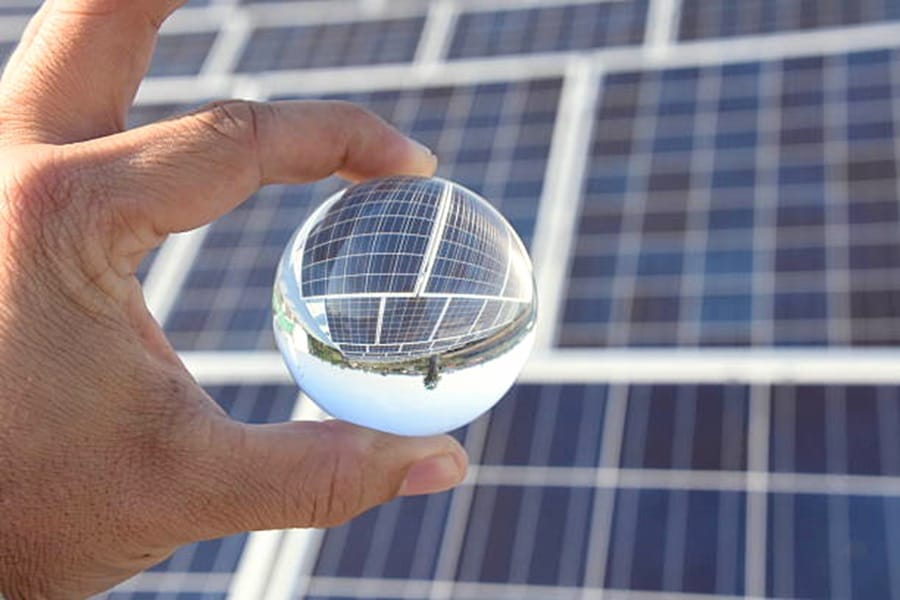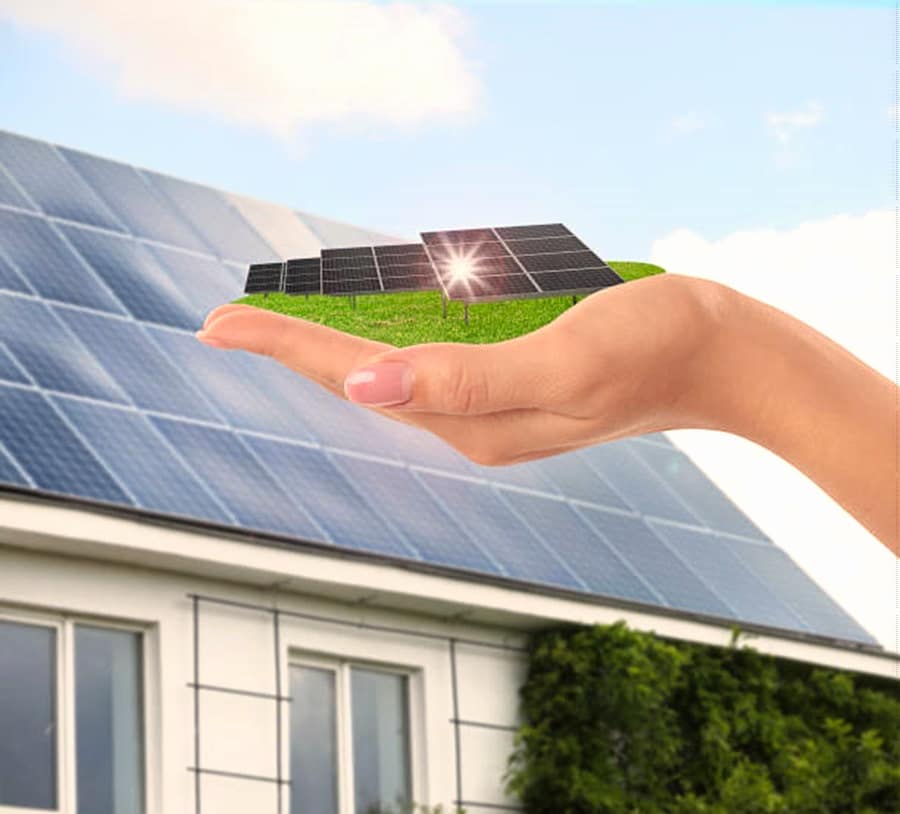
In this page
The Australian landscape, bathed in abundant sunshine, is a natural fit for harnessing solar energy. As homeowners and businesses become increasingly conscious of environmental and economic sustainability, 10kW solar panels are emerging as a popular choice for generating clean, renewable energy. But what exactly are 10kW solar panels, and are they the right fit for you?
Understanding 10kW solar panel systems
A 10kW solar panel system is a collection of individual solar panels that, when combined, generate a total output of 10 kilowatts (kW) of electricity. It’s important to note that individual panels themselves are not typically rated at 10kW. Instead, they come in smaller wattages, usually ranging from 370 watts (W) to 450 W, and multiple panels are connected together to form the complete 10kW system.
Here’s a breakdown of the key aspects of a 10kW solar system:
- Power output: As mentioned, a 10kW system generates 10,000 watts of electricity per hour under ideal conditions. This translates to an average daily generation of around 40kWh, depending on location, sunlight exposure, and system efficiency.
- Number of panels: The number of panels required in a 10kW system depends on the individual panel’s wattage. For instance, a system using 400W panels would require 25 panels (10,000W / 400W = 25).
- Suitability: 10kW systems are ideal for large homes with high electricity consumption, small businesses, or households planning for future needs like electric vehicles (EVs) or battery storage.
Are you prepared to embark on an electrifying journey with your next car? Brace yourself for a groundbreaking opportunity that will revolutionise your driving experience. Don’t miss out on this exclusive chance to book a test drive in one of the latest and most cutting-edge electric vehicles (EVs) available right in your very own neighbourhood!
Benefits of 10kW solar panel systems in Australia
- Significant energy savings: With an average daily generation of around 40kWh, a 10kW system can offset a large portion of your electricity needs, leading to substantial cost savings on your electricity bills.
- Reduced carbon footprint: Generating clean solar power contributes to a cleaner environment and a lower national carbon footprint.
- Increased property value: Homes with solar panels are often seen as more sustainable and desirable, potentially fetching a higher market value.
- Government incentives: The Australian government offers various incentives, like the Small-scale Technology Certificates (STCs) scheme, to encourage solar adoption and make 10kW systems more affordable.
Read more about:
- Home Solar Rebates, Incentives & Subsidies In Australia
- Solar power incentives, loans & rebates for small business
- Solar Battery System Rebates, Subsidies, & Incentives
- Australian Solar Feed in Tariffs Information
- Solar Feed-in Tariff Comparison: Best Tariffs by State and Territory
- Renewable Energy Certificates (RECs) information
- Large-Scale Generation Certificates (LGCs)
Factors to consider before opting for a 10kW system
- Energy consumption: Analyze your average daily or monthly electricity consumption to determine if a 10kW system aligns with your needs. Consider consulting a Clean Energy Council-accredited solar retailer for a personalised assessment.
- Available roof space: Ensure you have sufficient and suitable roof space to accommodate the number of panels required for a 10kW system. Factors like roof size, orientation, and shade need to be considered.
- Budget: While 10kW systems offer significant benefits, they have a higher initial investment than smaller systems. However, government rebates and long-term energy savings can offset the initial cost.
Alternatives to consider
While 10kW systems offer substantial power generation, they might only suit some. Here are some alternatives to consider:
- 6kW or 6.6kW solar systems: These smaller systems are well-suited for average-sized homes with moderate electricity consumption. They offer a good balance between affordability and energy generation. Read more about 6000 Watt Solar Panels | 6kW Solar Panel System.
- 9kW solar panels: A 9kW system can be an excellent middle ground between 10kW and smaller systems. It effectively caters to the needs of households with slightly higher energy consumption than the average. Read more about 9000 Watt Solar Panels | 9kW Solar Panel System.

How much roof space and solar panels are required for a 10kW solar system?
Most home solar panels have an output rating of between 330 and 400 watts, so a 10 kW system will need 25 to 30 solar panels, each measuring generally 1.7 by 1 metres, and roughly 80 m2 of roof space. Since they use newer technologies, more efficient solar panels often cost more and require less roof area.
How much energy can a 10kW solar system generate?
Depending on location, a 10kW solar system can generate 35 to 44 kWh daily electricity. A large household with electricity costs about $1,000 per quarter and may often be powered by a 10kW system’s panel output. The following table displays the output of a 10kW solar system in various Australian locations:
How much will you save on electricity bills with a 10kW solar system?
Solar feed-in tariff credits are a side benefit of installing a solar system. Instead, by “self-consuming” it or using the energy as it is made, you will get the maximum value of your solar energy. The more solar energy you use yourself, the more money you’ll save because solar feed-in tariff rates are often cheaper than what you’ll pay for energy from the grid; meanwhile, the extrasolar will flow into the grid and earn you credits that help lower your overall bill.
In Australia, feed-in tariffs can range between 3c and 20c, depending on the state and retailer. For example, 8 cents per kWh is paid for electricity exports in net metering. The average person purchases electricity from the grid for roughly 30 cents per kWh.
So if your (large) home or place of business uses only solar energy, the first year’s savings would be roughly about $4500. Yet, a household’s complete self-sufficiency in energy is unusual; there will be moments when your 10kW system exports to the grid.
Exporting 50% of the electricity would result in a $2700 annual savings.
Check out our page to learn more about Australia’s solar feed-in tariffs.
How long will it take a high-quality 10kW solar system to pay even?
But, this is open to modification. Most solar power systems often pay for themselves within the first five years. While some 10 kW solar systems can pay for themselves in as little as 3 to 4 years, some can take up to 5 years. It all depends on how much you consume.
The system’s payback period will be shortened if you use all the electricity produced at your house rather than redistributing it to the grid.
The payback period will be considerably longer if the solar system is installed in a seldom-used house, such as a vacation home. This is because you will export most of the generated power back to the grid at a slower feed-in rate.
Why choose 10000-watt solar panels?
There are several advantages to choosing 10000-watt solar panels for your home or business.
- They can generate enough electricity to power a large residential or commercial property. They are ideal for properties with high energy consumption or multiple occupants.
- 10000-watt solar panels are an environmentally friendly choice. They use renewable energy from the sun, which reduces the need for fossil fuels and lowers greenhouse gas emissions. By installing these panels, you can contribute to a more sustainable future and help reduce the impact of climate change.
- 10000-watt solar panels can help you save money on your energy bills. By generating your own electricity, you can reduce your reliance on the grid and avoid paying high electricity rates. Over time, the savings from using solar energy can offset the initial installation cost and lead to long-term cost savings.
How to install 10000-watt solar panels?
Installing 10000-watt solar panels in Australia requires careful planning and preparation.
- You need to have a solar assessment of your energy needs and determine how many panels you require. This will depend on your property’s size, energy consumption, and budget.
- You must choose a reputable solar installer to design and install your system. Choosing an installer with experience with high-capacity systems is important and can provide references and warranties.
- Once you have selected your installer, they will assess your property and determine the best location for the panels. This will typically involve mounting the panels on the roof or in a nearby location that receives ample sunlight. They will also install an inverter to convert the DC power generated by the panels into AC power that your household or business can use.
Find out how much you can expect to pay for solar
Ready to find out more? Get FREE quotes for solar, batteries + more
*Prices quoted are to be used as a guide only and do not factor in state and other rebates and incentives. Includes STC discount.
What is the cost of a 10000-watt (10kW) solar system?
A 10kW solar panel installation costs between $8,500 and $13,000. However, costs for 10kW systems vary depending on your location, the quality of the components, and your chosen installation firm.
Here are some approximate price ranges and other relevant details:
- Average price range
- A 10kW solar panel system typically costs between $8,500 to $13,000.
- Solar rebates depend on your system size and the sunshine hours in your postcode.
- Electricity production
- Depending on your location, a 10kW solar system can produce between 35 to 44 kWh of electricity per day.
- This output is typically enough to power a large household with electricity bills of around $1,000 per quarter or offset electricity usage for a fully electric lifestyle.
- Payback and savings
- The payback period varies based on location, electricity usage, and property suitability for solar.
- If you use more than 30 kWh/day, you could pay back your 10kW system within five years.
- High-quality solar panels may save you over $100,000 over the 25-year system life.
- Battery storage
- For a 10kW solar system with battery storage, expect to pay between $20,000 to $26,000 for full installation.
Use our easy-to-use solar power and battery storage calculator to determine the size of your solar system with storage! Our solar calculator will generate performance information and potential savings.
We can send this information to 3 of our pre-vetted and trusted local installers in your area to receive obligation-free solar quotes.
Ready to upgrade your solar systems and take your energy savings to the next level?
Embrace the energy efficiency revolution by upgrading your solar systems and adding a battery or solar inverters with Energy Matters.
Energy Matters recommends cost-effective solar batteries such as GoodWe, Enphase, sonnen, Fronius, Fimer, Sungrow, Tesla, Sigenergy and LAVO.
With our 3 free solar quotes, you can compare plans from pre-qualified and vetted installers in your area and find the perfect solution for your home and business. Harness the sun’s power and save money on electricity bills while reducing environmental impact. Let Energy Matters guide you towards a brighter, more sustainable future.








































